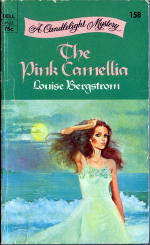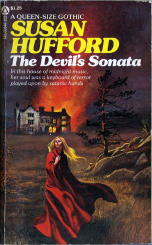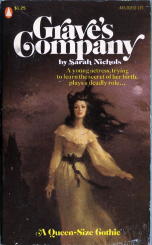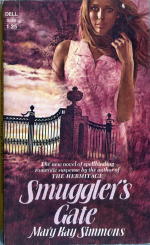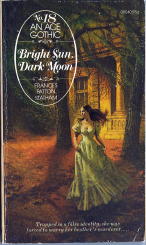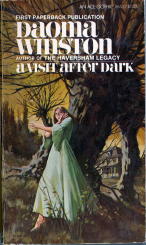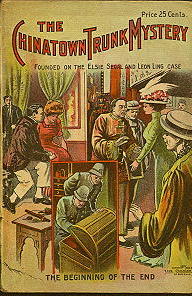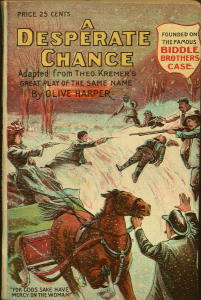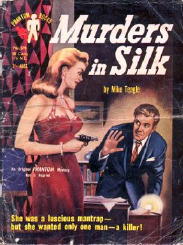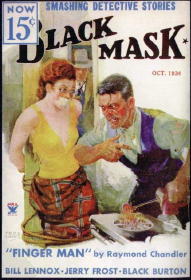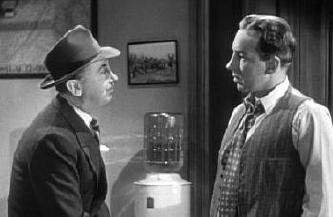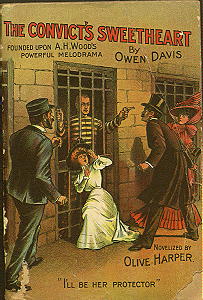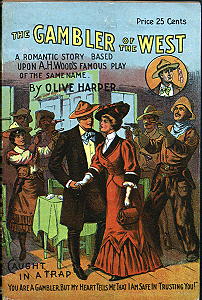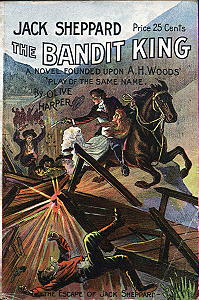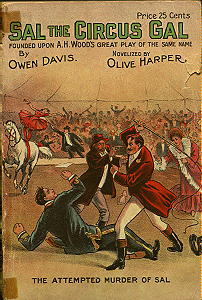June 2007
Monthly Archive
Fri 29 Jun 2007
DONALD E. WESTLAKE – Brothers Keepers
Fawcett Crest 2-2962; paperback reprint, no date stated. Hardcover edition: M. Evans & Co., 1975. Later paperback edition: Mysterious Press, 1993.
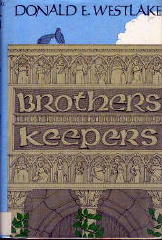
Donald Westlake has written a long list of crime and mystery fiction over his writing career, all of the books avidly read and well celebrated. He’s well regarded for his comic novels too, and sometimes his crime fiction and his comic novels are one and the same. Not so this time. Even though I’m reviewing Brothers Keepers here on Mystery*File, and wickedly funny it is indeed, it’s a stretch to call it crime fiction in any shape, whatsit or form. You really have to hunt to find anything truly criminous in it all all. Al Hubin in Crime Fiction IV agrees with me, marking the title with a dash in front, indicating that it’s only marginally crime-related.
For the basic plot line, I’m going to quote from the back cover of the Mysterious Press paperback. The book from Crest is actually closer at hand, since it happens to be the one I read, but I think the story is summarized a whole lot better in this later edition:
“Bless me, Father, for I have sinned,” confessed Brother Benedict of Manhattan’s Crispinite Order. And that was before the 19-year lease on the order’s Park Avenue monastery had expired, pitting its sixteen monks against a greedy real-estate mogul who could quote scripture like a pro. And that was before Brother Benedict fell head-over-heels in love with the greedy landlord’s daughter. Suddenly, from Midtown to the Caribbean, Brother Benedict has to play detective and ladies’ man in the noisy, profane and inexplicable world outside the monastery. And Brother Benedict had better not trip on his robe. Because, although he’s trying to save a house of God, all hell is about to break loose.
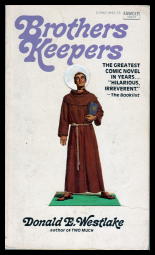
There’s some exaggeration there in the last line, I’m sorry to say, all the more to sell books, I’m sure, but the rest is fairly well on the mark. The only crime, as far as I could see, occurs on page 139, when the Brothers learn to their dismay that the lease to their monastery, the one that will prevent them from being evicted has been stolen. Was it an inside job? Or has someone managed to infiltrate the monastery without anyone noticing? Good questions, both.
As a purely personal matter, Brother Benedict may sin against God in this book, but his sins generally fall below the standard of being a crime, lust (for Mrs. Bone, the landlord’s divorced daughter) being not generally being a prosecutable offense in most courts of the land. Please note the outer cover of the Crest paperback (with the cutout hole part of the manufacture) versus the inner illustration behind. You may have a lot of sympathy for Brother Benedict’s anguish.
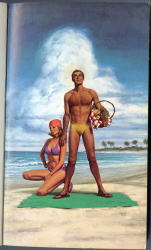
Quoting would be a good idea once again, I believe. From page 107 this time, as Brother Benedict, who tells the story, is taking his first ride in an automobile in ten years:
… Mrs. Bone, of course, was exactly like the girls usually filmed with these cars on television.
A red light at Sixth Avenue. The car stopped, Mrs. Bone glanced at me again, and by God I was looking at her, no doubt with the same equivocal expression as before. And I had been trying to think about the car.
She frowned at me. “How long have you been a monk?”
“Ten years.”
The light changed; she spun the wheel and we turned right onto Sixth Avenue. “Well,” she said, “that’s either too long or not long enough.”
I see Gina Gershon in the part. Maybe Matt Damon as Brother Benedict, although I haven’t thought about that half of the casting anywhere near long enough. A better name may come to me later.
I didn’t keep an exact count, but I’d estimate that this book averages a laugh-out-loud guffaw every six pages. This includes Brother Oliver’s comment about an edifice complex on page 68. This may not seem to you like a very high ratio, but considering all of the smiles and grins in between, and the fact that most books do not have a laugh-out-loud cause for guffaw anywhere in them at all, and I think you might pause to reconsider, and rightfully so.
In Pity Him Afterwards, a book by Mr. Westlake which I reviewed some time back, he showed me that he knows his way around a summer playhouse with the ease of one who’s been around one often, and on the inside. The same is true, as difficult as it may to believe, of Mr. Westlake and monasteries. Of course I’ve never been in one or part of one, and maybe I’m easily convinced, but if verisimilitude is what you’re looking for, as far as the settings where the books you read take place, this one has it, and in a bushel full.
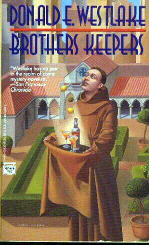
The only part of this small affair – but a huge one for the monks involved, who are almost totally ignorant of the ways of the outside world – that I am a little hesitant about recommending outright is the ending, which didn’t go in the direction I was thinking that it was going to go. But it’s still a terrific ending – I just read it again, and it certainly works for me.
What the heck. Forget my quibble. Let’s call it an outright recommendation. For a partially irreverent view of religion and the outside world of high finance as well, tossing in a bit of angst-filled bawdiness to boot, this is book that will challenge all comers, crime fiction or no.
Thu 28 Jun 2007
I don’t know if you know this, but I collect gothic romances. Nobody’s publishing them today. They’re dead in the water as far as today’s publishing world is concerned, as dead as can be, but from the mid-60s on into the later 1970s, they were as hot a category in bookstores and newsstands across the country as anything you can imagine, except for Harry Potter.
In the later 70s, the so-called bodice-ripper romances began to take over, and the gothics, which themselves on occasion verged into the supernatural, either continued on in that direction into occult fiction of various kinds, eventually becoming the very popular paranormal romances of today, complete with vampires, werewolves and all kinds of sexy shape-changers. Or, to continue on with the “either” in the preceding sentence, they became novels of romantic suspense, still very much a common category today.
I recently had the opportunity, while striving to “clean out” my basement, to go through a box of gothic romances I have – the ones having covers with a girl in the foreground and a spooky house in the background with a light on in a second story window – in order to add anything I find that’s new to add to Al Hubin’s Addenda for Crime Fiction IV. Most of these additions are in the form of previously unknown settings, but once in a while a brand new previously unknown title comes to fore, as happens once in the ten titles below.
All of this data is in Part 16 of the ongoing Addenda, which I’ve just uploaded this afternoon. As for Al, he’s still working and Part 17 is well under way. But please take a special look at the covers, if you would. I’m sorry they’re small enough that you can’t make out all of the details, but for variations on a theme, you probably couldn’t ask for much more than this, from a small sample of size ten.
JAN ALEXANDER. The Glass House. Add setting: Cape Breton Island (Nova Scotia)
LOUISE BERGSTROM. The Pink Camillia. Add setting: Washington state (San Juan Islands)
THERESA CHARLES. The Man for Me. U.S. title: The Shrouded Tower. Ace, 1966. Add setting: England.
SUSAN HUFFORD. The Devil’s Sonata. Add setting: Massachusetts [South Egremont].
PAULE MASON. The Shadow. US title: The Man in the Garden. Add setting: London (England).
SARAH NICHOLS. ADD: Grave’s Company. Popular Library, pbo, 1975. Setting: Ohio; past.
MARY KAY SIMMONS. Smuggler’s Gate. Add setting: Maine.
FRANCES PATTON STATHAM. Bright Star, Dark Moon. Note: Author’s full name is used on this book. Add setting: South Carolina (Charleston); 1883.
SHARON WAGNER. Dark Waters of Death. Add setting: Montana.
DAOMA WINSTON. A Visit After Dark. Add setting: Texas.
Wed 27 Jun 2007
Following up on the entry posted earlier here on Olive Harper, a lady who specialized in novelizing mystery plays around the beginning of last century, Victor Berch has made some revisions, corrections and additions to the previous list of books she wrote. None of these changes are major, but all of them are essential.
Many of these novelizations are, of course, included in Al Hubin’s Crime Fiction IV, but the true origins of these stories were not known for most of them when CFIV came out. This new entry for Olive Harper will show up shortly in the ongoing Addenda to the Revised Crime Fiction IV.
The changes have been made in the previous blog entry, which you can see by following the link above. Victor also sent along another ten or twelve more cover images, some of which you see here, but there are simply too many of them for small blog entries like this one. So what I’ve done is to create a new separate page on the original Mystery*File website page, one that’s large enough to hold them all, along with the newly revisions.
Take a look now, if you would, at www.mysteryfile.com/Harper/Compleat.html. It’s as complete now as we can get it. So far.
[UPDATE] 06-28-07. This didn’t take long, did it? Victor’s found two more cover images, and I’ve just uploaded them both to The Compleat OLIVE HARPER webpage. (See the link in the last paragraph above.)
Tue 26 Jun 2007
The Hillman-Curl cover scans found at Bill Deeck’s Murder at 3 Cents a Day website are complete now from 1936 to 1939, which marked the end of their “Clue Club” line. I uploaded the covers for 1939 over the weekend, but I haven’t had a chance to let you know till now. (It’s been a busy week, and it promises to get even busier.)
Included in this last batch are a Bulldog Drummond title by Gerald Fairlie, one by pulp writer Steve Fisher, and two by Barry Perowne, one of them a Raffles adventure. Coming next: perhaps Arcadia House (1939-1967) or Mystery House (1940-1959), but one of the smaller companies like Gateway (1939-1942) may sneak in ahead of both of the two larger ones.
Sun 24 Jun 2007
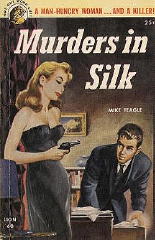
There’s not much that’s known about a mystery writer named Mike Teagle. He wrote a pair of detective novels published by Hillman-Curl in the late 1930s, but after the second was published, he seems to have vanished completely. There’s not a single source that has any biographical data about him. The two books appear to be the only legacy he’s left behind.
We can make some preliminary judgments and surmises, though. Since “Mike Teagle” is a character in his first book, the odds are that the name’s a pseudonym — possibly but not very likely to be the author’s too. Bill Pronzini says, “Judging from the political story, theme, and characters in Death over San Silvestro, I would guess that he was a newspaperman with leftist leanings, probably based in New York City or environs. His knowledge of NYC and Long Island is evident in the background descriptions in Murders in Silk.”
Bill goes on to say: “Both novels are ultra-hardboiled. I prefer Silk, but that’s because I’m not a political animal. Silk is flawed, but it has well-drawn characters, good dialogue, an abundance (probably an overabundance) of violent action, and moves at a breakneck pace.”
Death Over San Silvestro. Hillman-Curl, hardcover, 1936. Two printings known.
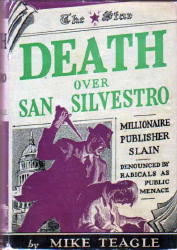
Leading character: Mike Teagle, bodyguard.
Setting: New York City
Jacket Blurb: Every American is a suspect in the strange murders which rock the country as the people of he United States approach their most crucial presidential election.
In the midst of this fog of death and hidden conflict moves the figure of Horace J. Breasted, sometimes sinister, always powerful, driving ruthlessly toward his secret goal. A strange man, Horace J. Breasted – a multi-millionaire publisher of newspapers and magazines, friend of presidents and foreign dictators, paramour of beautiful women, owner of vast fields and factories and mines. A man hated by millions, feared by millions, envied by millions – doomed to die at the hands of an assassin.
Caught up with Breasted in this whirlwind of mystery and danger are the President of the United States and his Republican opponent, gangsters and society matrons, show girls and senators, a general with a secret, and a girl with a cause. Caught up with them, flung about in the madness of speeded-up America at the crisis, are all the others, too – millionaires and starving men, Communists and Fascists, Democrats, Republicans and Socialists.
How many of these are involved in the mysterious murders that shock America? Which of these know the forces that are at work behind the scenes to gain power over the American people for their own secret purposes? And which of these will be the next to die?
Review excerpts: “The book is probably the nearest thing to Marxist mystery-mongering the circulating library patrons have had to date.” – Carlton Brown, New Republic
“The story is well told, but it leaves a bad taste in the mouth.”– Isaac Anderson, New York Times
“Tough ’n terrible.”– Saturday Review of Literature
[Taken from the front flap of Murders in Silk:]
“Makes The Thin Man seem like a juvenile.” – Alvin C. Hammer
“Most audacious mystery novel of the year.” – Toledo News Bee
“The most exciting fiction story you have read since the ban was lifted on Nick Carter.” – Springfield Union
Murders in Silk. Hillman-Curl, hardcover, 1938. Mystery Novel of the Month, no number [#1], digest paperback, no date. Lion #60, paperback, 1951. John Long, UK, hc, 1939. Phantom Books #598, Australia, digest pb, 1954.
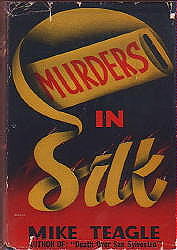
Leading characters: Tiberius Bixby and Zeb Bixby.
Setting: New York City and Long Island
Jacket Blurb: The troubles of Tiberius Bixby began when the man with the purple tie got his throat cut in the women’s washroom on a Long Island Railroad train. And mixed up in the bloody jigsaw jumble were:
The girl in the red calot who strangely hid her knowledge of a dead man and thought murder didn’t constitute a social introduction;
The blonde Paula, who celebrated because her father was mysteriously burned to death;
Nicky Pet and the woman dentist; a Ghurka knife and the cryptic cry of a dead man’s wife – all tangled in a fog of alcohol and murder.
What have all these to do with silk?
The answer was found by eccentric old Pa Bixby, who, at seventy, was still able to appreciate a well-filled stocking as he mixed his whiskey with philosophy.
Review excerpts: “The story is fast, slick, exciting and altogether an outstanding example of the tough trend; it also contains additional features in the way of character and real amusement. If you must have a ten-minute egg, read Murders in Silk.” – Will Cuppy, Books
“Good-natured cynicism, a clever plot well told, and a seventy-year-old chronic alcoholic make this book a feature of the mystery season. Three murders … and a wholly surprising denouement are some of the other factors that entitle this story to high praise.”– Boston Transcript.
Sun 24 Jun 2007
W. T. BALLARD – Hollywood Troubleshooter. Edited by JAMES L. TRAYLOR. Popular Press, Bowling Green University; trade paperback; 1985. Also published in hardcover.
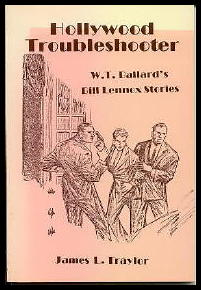
Subtitled “W. T. Ballard’s Bill Lennox Stories,” not only does this book contain five of the twenty-seven of them that appeared in Black Mask during that magazine’s heyday, probably the best-known detective pulp of them all, but all of the following are included as well: an overview of Ballard’s career by Traylor and a short biographical sketch by Ballard himself, both extremely informative; an introduction to the Lennox stories and novels; and last but not least, a complete bibliography for all of Ballard’s long and prolific writing career.
It’s a cliché, I suppose, but this is a book that should be on the shelf of every pulp detective fan, no ifs, ands or buts. After a lengthy career for the pulp magazines — even before he started writing for Black Mask in 1933, he had already been published in the October 1927 issue of Brief Stories — Ballard switched with the times to writing novels, some in hardcover, but most of them paperback originals.
When he found the market for his mystery fiction was drying up, Ballard switched to writing westerns, most of these coming out under the pen names of either Todhunter Ballard or John Hunter. In the 1950s and 60s he wrote a number of television plays as well, for such series as Death Valley Days, Wild Bill Hickok and Shotgun Slade.
While the Lennox stories in Black Mask appeared only from 1933 to 1942, he was apparently fond enough of Lennox as a character to continue writing about his adventures in hardcover form: Say Yes to Murder (Putnam, 1942), Murder Can’t Stop (McKay, 1946), and Dealing Out Death (McKay, 1947). Much later on, a fourth book, Lights, Camera, Murder (Belmont, pb, 1960), finally appeared, published for some reason under the name of John Shepherd.
Here’s a suggestion from me. Lennox may have been the first Hollywood troubleshooter to have appeared in fictional form, the right-hand man for Consolidated Studio’s production chief, Sol Spurck. Having no specific title, according to the last of the five stories in this book, Lennox’s assignment was “to iron out whatever bottlenecks developed in the production schedule.” Murder is often one of those bottlenecks, as well as any other kind of behavior that might affect the studio’s star and starlets — including blackmail, crooked horse racing, gambling debts or the like. (Hollywood, crime and cover-ups somehow seem to go together naturally, at least in days gone by, if not today.)
Whenever a pulp writer got a hot series going, there was often of crew of regulars that began to appear in the same stories the main character did, and Ballard was no different. (He may even have been one of the forerunners of the idea.) Given only self-contained glimpses here and there, and spread over the run, you won’t get the full flavor of this in the same way that a long-time regular reader of Black Mask might have been able to, but Nancy Hobbs, for example, who writes about movies, has short but very striking roles in the first two of them. Later on, it comes as no surprise to learn, she appears in his adventures as a long term girl friend and lover, although marriage does not seem to be in the cards for either of them.
The earlier stories are told in the more terse hard-boiled style popularized by Dashiell Hammett, but by the end of the run some personal background had been built up around Lennox, making him a bit more human — but without losing any of the sheer sensationalism of the pulps. Lennox’s final Black Mask appearance, for example, is a case in which a killer sends his victim through the buzzsaw at a still very much functioning lumber mill.
Although the tales contained in the book are, in all honesty, not among the finest the pages of vintage pulp magazine fiction can offer, they’re certainly right up there in the second level from the top. And if you’re like me, when you’ve finished reading the five in the book, you’re going to wish that somebody would publish them all of the Lennox stories, and then the “Red Drake” ones, then all of the Ace G-Man Stories, and on and on and on.
Stories contained in this volume, all from Black Mask:
“A Little Different” September 1933 [Lennox’s first appearance]
“A Million-Dollar Tramp” October 1933
“Gamblers Don’t Win” April 1935
“Scars of Murder” November 1939
“Lights, Action — Killer!” May 1942 [his last magazine appearance]
Postscript: Looking back at this review several days later, all I can think of is that I didn’t provide you with an excerpt from any of the stories. This one’s from early in the very last one, “Lights, Action — Killer!” I don’t think it needs any more introduction from me, other than to say that Lennox is talking to Sol Spurck about the latter’s latest movie, which is in trouble, as usual:
“The script,” said Lennox, “stinks.” When he had first come west, he had been surprised at the language which served the film colony, but after six years he spoke no other. He was too busy to think about himself, his likes or dislikes.
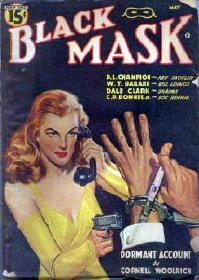
At first he had dreamed of writing a book, a lot of books, but as the weeks drifted into years, he still spoke of quitting pictures, of going east and settling down to write.
That time never seemed to come. Through experience, he had learned to make his interest, his enthusiasms, and his softer feelings under a shell of hardness which was the only phoney thing about him. He had become flippant, since the town understood nothing else. He had ceased to admit that he could read, or that he liked good books. He gambled when he could, needing the false excitement of the game as a safety valve for his nerves.
But although he refused to admit it, even to himself, he was still moved by enthusiasm for each new picture, still hoped that some day someone would cut loose and make, not the old formula story, but something really new, something different. All the bitterness and boredom of his job was in his voice when he said, “They dipped the barrel dry for hokum on this, Sol. If we had Pearl White, we could make the greatest serial out of this that was ever made.”
“Funny,” said Spurck. “Mama and I was just talking at dinner. Them old days was different. Pictures was fun then, and not always the headache which we have now got.”
— August 2004
UPDATE [06-23-07]. Here, for the sake of completeness, is a complete list of Lennox short fiction:
“A Little Different” (September 1933,
Black Mask)
“A Million Dollar Tramp” (October 1933,
Black Mask)
“Positively the Best Liar” (November 1933,
Black Mask)
“Trouble-Hunted” (January 1934,
Black Mask)
“Tears Don’t Help” (April 1934,
Black Mask)
“That’s Hollywood” (May 1934,
Black Mask)
“Whatta Guy” (July 1934,
Black Mask)
“Crime’s Web” (September 1934,
Black Mask)
“Snatching is Dynamite” (October 1934,
Black Mask)
“In Dead Man’s Alley” (November 1934, Black Mask)
“Murder Isn’t Legal” (December 1934, Black Mask)
“Gambler’s Don’t Win” (April 1935, Black Mask)
“Numbers With Lead” (January 1936, Black Mask)
“Blackmailers Die Hard” (May 1936, Black Mask)
“Whipsawed” (December 1936, Black Mask)
“There’s No Excuse for Murder” (September 1936, Black Mask)
“This is Murder” (March 1937, Black Mask)
“Fortune Deals Death” (July 1937, Black Mask)
“Mobster Guns” (November 1938, Black Mask)
“No Parole from Death” (February 1939, Black Mask)
“Scars of Murder” (November 1939, Black Mask)
“Pictures for Murder” (September 1940, Black Mask)
“The Lady with the Light Blue Hair” (January 1941, Black Mask)
“Not in the Script” (July 1941, Black Mask)
“Murder is a Sweet Idea” (November 1941, Black Mask)
“The Colt and the Killer” (February 1942, Black Mask)
“Lights, Action — Killer!” (May 1942, Black Mask)
Now don’t you wish that someone would publish them all?
Sat 23 Jun 2007
I don’t know about you, but whenever I come home from a book-hunting expedition and start going through my finds and come across an author I’ve never heard of before, I immediately go to Al Hubin’s Crime Fiction IV to see what other mystery fiction he might have done.
Case in point. George Adams, whose entry in CFIV looks like this:
ADAMS, GEORGE (1936- )
* Swindle (Pocket Books, 1989, pb) [Charlie Byrne; New York City, NY]
* Insider’s Price (Pocket Books, 1993, pb) [Charlie Byrne; New York City, NY]
The book I bought while on the road was his first one, Swindle, and thanks to the Internet, it wasn’t too difficult to find his other one. Nor was it too expensive. I don’t think the demand is very high, but let’s see if I can’t do something about that. Maybe I’ll succeed, and maybe I won’t, but it’s worth a try.
Swindle. Pocket, paperback original; 1st printing, February 1989.
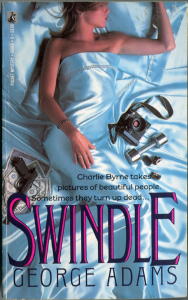
From the back cover:
THE CAMERA NEVER LIES …
Charlie is a high-fashion photographer, part-time bicycle racer and a full-time lover. Manhattan is his playground. But when his sexy stylist loses $50,000 to a phony investment scheme. Charlie makes his first mistake. With the help of an out-of-work actor and a very busy hustler he sets out to scam the scammer – and get the money back. Instead, he finds a money-mad netherworld of insider trading, wiseguys, murder and sex, and there’s no telling the good guys from the bad … A gorgeous woman and a Wall Street wizard are the heavy hitters in a ruthless game to separate New York’s most beautiful people from their money. Charlie Byrne has wandered right into the middle of a nightmare that could only happen in New York – and getting out will be as simple as staying alive.
About the author:
Like his hero, Charlie Byrne, George Adams is a well-known New York advertising photographer who can be found racing his bike in Central Park on Sundays. Unlike Charlie, he almost always finishes the New York Times crossword puzzle. Adams’ work appears on the front cover of this book.
Review excerpt: [Chicago Sun-Times] “A page turner with lots of twists and turns, flesh-and-blood characterizations, and swift and rhythmic prose. It’s hard to believe Swindle is a first novel.”
Insider’s Price. Pocket, paperback original; 1st printing, September 1993.
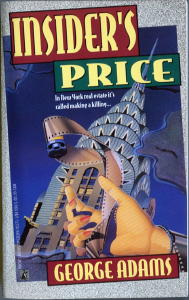
From the back cover:
THE ART OF THE STEAL
High-fashion photographer Charlie Byrne heads from his humble midtown digs to the Upper East Side when old acquaintance JoJo Cyzeski – now Josephine – hires him to shoot a priceless Aubusson tapestry. The tapestry, and the fabulous co-op, belong to Marc Ransom, megabucks New York real estate developer and legendary ladykiller. But a darker side to the glittering world develops when the shoot is short-circuiited by a blackout and an apparent suicide in the adjoining courtyard. That’s when Charlie meets the gorgeous sister of the dead woman, who leads him into the gilded precincts of real estate royalty, where doing business can be murder….
From a terrifying Times Square fleabag hotel to a penthouse bought with drop-dead deals, from the homeless woman camped in his doorway to the bevy of beauties in Ransom’s collection, Charlie follows clues to the suspect suicide and lands on the bottom line of the New York real estate game – where monopoly is played for keeps.
From inside the front cover:
IF THE STAIRWELL WAS A GOOD PLACE TO GET MUGGED, THE ELEVATOR WAS EVEN BETTER …
I leaned on the button continuously. “Come on,” I pleaded.
A woman’s scream pierced the ambient sound of TV’s and ghetto blasters. “He’s an old man, leave him alone!” Smack! Then a baby was bawling.
Tito and I swapped looks. We bolted down the corridor. A spindly black girl, a bawling child on her hip, sobbed into her hand. Four goons were working someone over.
Tito leveled the Nikon to his eye and fired. They froze like statues. The flash etched them on my retina. One was Angel. The bandaged one was James. The other two were strangers. An old man was lying on the floor.
“Yo, James, lookee ’ere.” Angel grinned, his vision clearing.
One of them flicked open a switchblade. The four of them advanced.
Tito and I began backpedaling. I sighted my camera and let them have a blast of strobe. The flashes took forty seconds to recharge, an eternity. We’d shot our load …
“Get ’em,” Angel barked …
Fri 22 Jun 2007
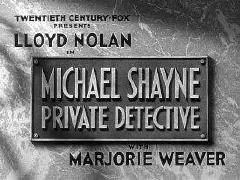
MICHAEL SHAYNE: PRIVATE DETECTIVE. 20th Century Fox, 1940. Lloyd Nolan, Marjorie Weaver, Walter Abel, Elizabeth Patterson, Donald MacBride, Douglas Dumbrille. Based on the novel Dividend on Death, by Brett Halliday. Director: Eugene Ford.
Some random thoughts that may shape themselves into a review, and maybe not. What you see is what you get. The recently released DVD set of the first few Shayne movies calls them noir. Not so. It’s a good selling point, but when it gets to the point that every black and white movie made in the 1940s with a crime or mystery in it is called noir, the word simply no longer has any meaning.
The first true noir film may have been The Maltese Falcon; I really haven’t thought about it too much, but it certainly could have been one of the first. I suppose it all depends on your own personal definition of noir.
MSPD came out a few months before TMF, and it may have been a step in the right direction, but it’s way too light-hearted, and Lloyd Nolan is a little too goofy in the leading role, for the film, based on author Brett Halliday’s Dividend on Death, to be anything close to noir, using anyone’s definition. TMF is played straight, giving audiences the feeling for what a tough mystery film (as opposed to gangster movie) could really be like.
At least, as I thought for a while, Michael Shayne doesn’t have a stooge for a sidekick in this movie — another step in the right direction — but on the other hand, Chief Painter (Donald MacBride) has a cop as his right hand man who is as dumb as they come, and Shayne does have Aunt Olivia (Elizabeth Patterson), who’s a dedicated fan of Ellery Queen, murder mysteries and The Baffle Book, to give him strong support when it counts.
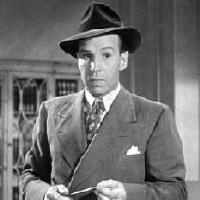
Nolan I called goofy, but he’s still immensely enjoyable in the role, as long as you don’t think of him as Brett Halliday’s Michael Shayne. Seeing the repo men moving the furniture out of his office at the beginning of the film, when cases have apparently been tough to come by for him, certainly sets a certain tone. And watching him cover himself with a blanket when Phyllis Brighton (Marjorie Weaver), whom he’s been hired to bodyguard by her rich father, catches him with his pants down, is mildly funny but hardly, I suspect, how the real Michael Shayne might have reacted in the same situation.
Not that the real Michael Shayne was really truly tough-as-nails hardboiled or one of theose super-sexed PI’s who came along later, but Lloyd Nolan, he wasn’t either.
Perhaps as the series goes along, given the TMF influence, the humor lessens and the mystery is played straight, but even if it doesn’t, I’m not going to be concerned about it.
The story has to do with a gambling casino, horse-racing, a murder, a ditched dame, a possible suicide note, the switching of the barrels of two guns, a bottle of ketchup and a piece of jewelry that comes unpinned at the wrong time, perhaps even a couple of times. It really is a complicated case, I grant you that, which is one of the things I had in mind when I called this a possible transition into true noir from detective films that felt they also had to make the audience laugh.
It’s remarkable, looking back now, how all of the plot is made to fit into a tight 77 minutes, which I have a hunch is a little longer than the average murder mystery movie at the time. I’ve watched it twice now, and there’s not a minute that’s really wasted. It was well worth the time, and if I may say so, probably yours as well.
Fri 22 Jun 2007
Although I’m not sure what the first book was which “novelized” a movie, I know that it’s not a recent innovation, and in fact the idea is even older than that. Even before movies came along, around the turn of last century, what audiences took a good deal of pleasure in watching were plays in live performance, many of them mysteries, and would you believe, these plays were often novelized.
This is hardly a formal article on the subject. It’s too early for that. Very little has been written about the novelizations of plays, and it’s obvious a much longer piece is needed to say everything there is to say. From what Victor Berch has told me, though, at the end of the 19th century and into the first part of the next, there were three or four publishing houses that specialized in such works of fiction, and there may have been more. The most prolific of these was the J. S. Ogilvie Publishing Company, of New York. Street & Smith did some, Victor says, and I. & M. Ottenheimer of Philadelphia did some as well.
One of the authors who specialized herself in turning plays into novels, usually in softcover form, was the pseudonymous Olive Harper, whose entry in Crime Fiction IV, by Allen J. Hubin, Victor has recently revised and which you’ll see below.
This information will also show up soon in an upcoming Addenda to the Revised CFIV. Victor has sent me cover images for four of this books, and perhaps – just maybe – the titles themselves will be enough to start you off in a new direction for your mystery collecting activities.
Warning: The books below are not easily found. While not expensive, generally under $20 each, only a handful of the titles below could be found by taking a quick look on www.abebooks.com. A few of the author’s non-mystery novelizations and translations show up also, but at the present time, only four of them are mysteries (not, as I recall, the same four that are shown below).
HARPER, OLIVE, pseud. of HELEN BURRELL GIBSON D’APERY, 1842-1915
Bertha, the Sewing Machine Girl (Ogilvie, 1906, pb) Novelization of play in 4 acts by Theodore Kremer [New York City]. Silent film: Fox Film Corp., 1926 (scw: Gertrude Orr; dir.: Irving Cummings)
The Burglar and the Lady (Ogilvie, 1912, pb) Novelization of play in 4 acts by [Arthur] Langdon McCormick. Silent film: Sun Photoplay, 1915 (scw: [Arthur] Langdon McCormick; dir.:Herbert Blache).
*Caught in Mid-Ocean (Ogilvie, 1911, pb) Novelization of play in 4 acts by Arthur J[ohn] Lamb. [London, ship]
*The Chinatown Trunk Mystery (Ogilvie, 1909, pb) Novelization of play in 4 acts by Owen Davis. [New York City]
The Convict’s Sweetheart (Ogilvie, 1909, pb) Novelization of play in 4 acts by Owen Davis [Colorado]
The Creole Slave’s Revenge (Ogilvie, 1908, pb) Novelization of play in 4 acts by Walter Lawrence, pseud. of Owen Davis [Louisiana]
*The Desperate Chance (Ogilvie, 1903, pb) Novelization of play in 4 acts by Theodore Kremer
Fighting Bill, Sheriff of Silver Creek (Ogilvie, 1907, pb) Novelization of play in 4 acts [California]
The Gambler of the West (Ogilvie, 1906, pb) Novelization of play in 4 acts by Owen Davis
It’s Never Too Late to Mend (Ogilvie, 1907, pb) Novelization of the 4-act play It’s Never Too Late to Mend; or, The Wanderer’s Return by Owen Davis [New York City]
Jack Sheppard, the Bandit King; or, From the Cradle to the Grave (Ogilvie, 1908, pb) Novelization of play in 4 acts by Owen Davis [California]
King of the Bigamists (Ogilvie, 1909, pb) Novelization of play in 4 acts by Theodore Kremer
The Millionaire and the Policeman’s Wife (Ogilvie, 1908, pb) Novelization of play in 4 acts by Owen Davis [New York City]
* A Millionaire’s Revenge (Ogilvie, 1906, pb) Novelization of play in 4 acts by [James] Hal[leck]
Reid [New York City]
On Trial for His Life (Ogilvie, 1908, pb) Novelization of play in 4 acts by Owen Davis [West]
The Opium Smugglers of Frisco; or, The Crime of a Beautiful Opium Fiend (Ogilvie, 1908, pb) Novelization of play in 4 acts by Owen Davis [San Francisco]
The Queen of the Outlaw’s Camp (Ogilvie, 1909, pb) Novelization of play in 4 acts by Edward M. Simonds [Colorado]
The Queen of the Secret Seven (Ogilvie, 1909, pb) Novelization of play in 4 acts by Ike Swift, pseudonym of Owen Davis [New York City]
The River Pirates (Ogilvie, 1909, pb) Novelization of play in 4 acts by Walter Lawrence, pseud. of Owen Davis. [New York City]
Sal, the Circus Gal (Ogilvie, 1909, pb) Novelization of play in 4 acts by Owen Davis [Chicago]
The Shadow Behind the Throne (Ogilvie, 1908, pb) Novelization of play in 5 acts by Alicia Ramsay and Rudolph de Cordova
The Shoemaker (Ogilvie, 1907, pb) Novelization of play in 4 acts by [James] Hal[leck] Reid [New York City, Wyoming]
A Slave of the Mill (Ogilvie, 1905, pb) Novelization of play in 4 acts by [James] Hal[leck] Reid and Harry Gordon
Tony, the Bootblack (Ogilvie, 1907, pb) Novelization of the 4 act play Tony the Bootblack; or, Tracking the Black Hand Band by Owen Davis [New York City, Italy]
Wanted by the Police (Ogilvie, 1909, pb) Novelization of play in 4 acts by [Arthur ] Langdon McCormick [New York City]
* Based on true crimes.
Thu 21 Jun 2007
Al Hubin and I are convinced that we have correctly identified the author of Murder in the Medical School (iUniverse/Writer’s Club Press, December 2000), as Dr. James Roy Schofield, who died on May 20th, 2007.
The reason I’ve phrased that opening paragraph the way I have is on the page where the book is for sale on Amazom.com, the author is said to be Jill R. Schofield, M. D. The latter name is also somehow connected with the ISBN number, since at least half of the sellers on ABE have entered it that way, also referring to the author as Jill. A check on Google uncovers a Dr. Jill Schofield with a practice in Aurora CO.
On the other hand, and even more convincing, is Dr. James Roy Schofield’s Who’s Who entry, and his book, a mystery novel which just managed to make the end of 2000 deadline for inclusion in Crime Fiction IV, is definitely mentioned, along with some other data about him.
Born July 12, 1923, Dr. Schofield received his MD from Baylor University in 1947 and a LLD from Queens University in Ontario, Canada, in 1988. As an educator, he was a member of the faculty of the Baylor University College of Medicine from 1947 to 1971, eventually becoming its Academic Dean. After leaving Baylor, he worked for many national medical associations, including the AMA, as a consultant on medical education.
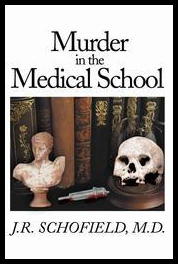
All of which certainly means that the background for his mystery novel was authentic. Here’s a description of the book, as taken from the back cover:
A particularly gruesome murder occurs in the Anatomy Department of a 1950’s medical school. Included is a graphic description of anatomical and pathological specimens in the Anatomists’ cadaver preparation room.
The novel begins with preparations by the Anatomists to prepare a teaching exhibit of human structures in one-inch cross-sections of a human cadaver.
The medical school is expanding into new clinical departments; recruitment of several departmental Chairs is described – showing the quite variable characteristics of several clinical specialists.
The narrator describes life in and problems of the medical school. The reader can follow selection of new medical students, academic disputations about the M.D. curriculum behavior of some physicians in private practice, split opinions over the locations of the new charity hospital and a typical M.D. graduation ceremony – with the administration of the ancient Oath of Hippocrates to the graduates. The narration is flavored with references drawn from the History of Medicine.
Was there a murder? A person on staff of the medical is missing; but no body could be found. The arrival of the missing person’s girl friend triggers the attention of the police; but, until the penultimate chapter, there is no solution until the two young anatomists convince the detective that they have solved the missing body question.
Not until the Epilogue, is the identity of the murderer revealed, and how he did it.
Perhaps it was never a bestseller, but more than six years later, Amazon still has copies of Murder in the Medical School in stock. Its sales ranking is #2,521,639, but the number must be put in perspective. Amazon offers well over four million books for sale.
Next Page »





